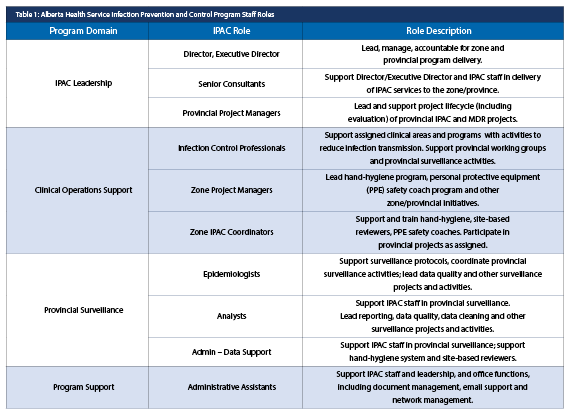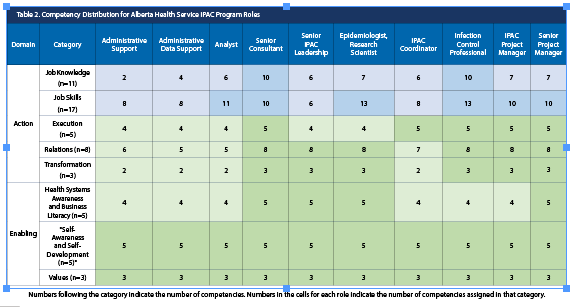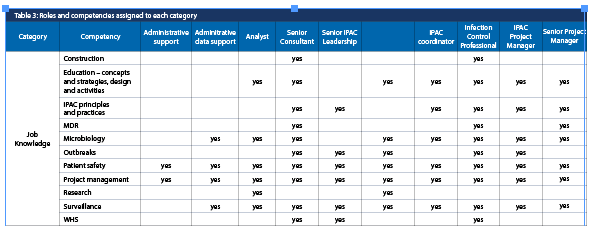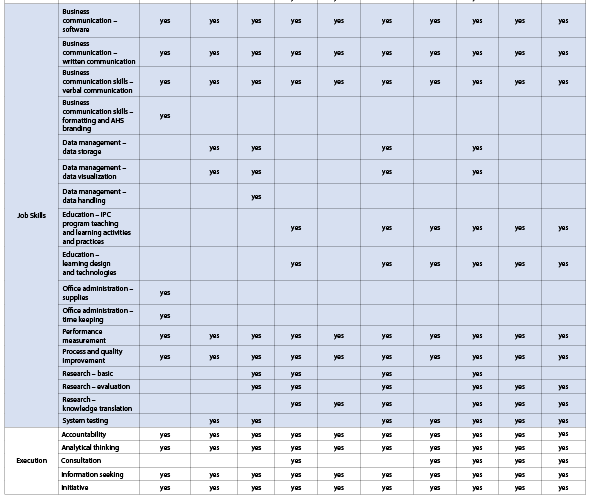Kathryn Bush, MSc1*, Jenine Leal, PhD1,2,3,4, Lisa Acorn, RN, BN, CIC1, Melody Cordoviz, RN1, Fred Cundict, BSc, BEH (AHS), CIPHI, CIC1,
Alison Devine, RN, BScN1, Courtney-Lynn Edwards, LPN1, Peggy Fletcher1, Yvette Gable, RN1, Heather Gagnon, BA, BSc, MPH1,
Sara Gallinger, RN, BScN1, Victoria Gill, MSc1, Bernice Heinrichs, MN, CIC1, Blair McFerran, BSc, B.EH1, Craig Pearce, MSc1,
Ted Pfister, MSc1, Gwyneth Meyers, PhD1.
1. Infection Prevention and Control, Alberta Health Services, Alberta, Canada
2. Department of Community Health Sciences, Cumming School of Medicine, University of Calgary, Calgary, Alberta, Canada
3. Department of Microbiology, Immunology and Infectious Diseases, Cumming School of Medicine, and, University of Calgary, Calgary, Alberta, Canada
4. O’Brien Institute of Public Health, University of Calgary, Calgary, Alberta, Canada
*Corresponding author:
Kathryn Bush
Suite 801, South Tower
Foothills Medical Centre
3030 Hospital Dr. N.W.
Calgary, AB T2N 4W4
Canada
Tel: 587-226-6598 | Email: kathryn.bush@ahs.ca
ABSTRACT
There is an ongoing evolution of competencies for infection prevention and control (IPAC) team members. While some roles in an IPAC program have competency models as a professional development resource, including the IPAC Canada competencies for infection control professionals, a competency framework to describe the various IPAC program roles and assess their proficiency has not been published. The Alberta Health Services IPAC program has created a framework outlining competencies for the roles in a multi-disciplinary team. This allows all staff to understand their professional development opportunities, and provides the IPAC leadership with an understanding of their multi-disciplinary team for role integration, hiring decisions, and succession planning.
KEYWORDS Competency, proficiency, professional development, succession planning, IPAC program, staff roles
INTRODUCTION
Infection Prevention and Control Canada (IPAC Canada) defines competency statements as “the expectations of one who is able to perform effectively in the roles and functions required by his or her position and within the team and organization” [1]. The recent update to IPAC Canada’s “Core Competencies for Infection Control Professionals” demonstrates the ongoing evolution of competencies for infection prevention and control (IPAC) team members [2].
The Alberta Health Services (AHS) IPAC program identified a strategic goal to understand competencies for every role in the program: to highlight staff achievements, and to encourage staff to expand their scope of practice through professional development. The intent is to inspire IPAC staff to define and leverage their career goals and to support IPAC leadership in fostering growth and succession planning. There are many published healthcare competency models [2-8], but to-date, there has not been a competency framework which synthesizes these to describe every role in an IPAC program.
The AHS IPAC program framework uses published role competency models and organizes these around the Health Leadership Competency Model 3.0 [7]. This competency model is organized into an “action” domain, describing staff in the context of their work (execution, relations, transformation); and an “enabling” domain, describing staff’s understanding and preparation to work in a healthcare setting (health systems awareness, self-awareness and self-development values).
While the IPAC Canada competency model focuses on a “proficient” level, the model of the Association for Professionals in Infection Control (APIC) includes other dimensions of proficiency within each competency [9]. This additional information provides staff the opportunity: 1) to assess their current competency level; 2) to determine if they wish to acquire new competencies or improve their proficiency in existing competencies; and, 3) to establish a professional development plan.
This practice article describes the process of creating an IPAC program competency framework which outlines the specialized and shared competencies for the many roles in an IPAC team. The framework builds on the IPAC Canada competencies to illustrate how role competencies can be used to enhance an IPAC program.
METHODS
To begin the development phase, a literature search was conducted to gather competency models for the AHS IPAC program roles. Role competencies were grouped under the Health Leadership Competency Model domains [7]. Duplicates were removed since many competencies were included across competency models: e.g., “professional development” and “accountability” are common across most competency models. Beginner, proficient and advanced levels were defined for each competency using AHS performance expectations and expert opinion. The competencies were assigned for all roles regardless of the originating competency model based on an assessment of the roles’ skills, knowledge and accountabilities.
The draft competency framework then entered the consensus phase with a working group representing all AHS IPAC roles: two directors, two senior consultants, one epidemiologist/analyst, four infection control professionals, two project managers, one coordinator, and one administrative support person (see Table 1). These staff represented zone IPAC teams and the provincial team with equal participation from rural and urban zones. Review considerations included: accurate competencies listed for each role; clear language used for descriptions; and proficiency levels appropriately described. Where published competencies or proficiency descriptions for a role were not available, the working group created those and came to agreement. While not all competencies were relevant for all staff in a specific role – e.g., not all infection control professionals participate in computer system testing – the competency was included in the role profile if any of the AHS IPAC staff in that role performed the function. The working group also came to consensus on the tools, checklists and background information created for the implementation of the competency framework.
RESULTS
The AHS IPAC framework (see Table 3) includes 57 competencies organized into the action and enabling domains of the Health Leadership Competency Model [7]. There are 10 roles identified in the AHS IPAC program
(Table 1), and 36% (16/44) of the action domain competencies and 92% (12/13) of the enabling domain competencies are common across all roles (Table 2 and 3). Most of the specialization in role competencies occurred in the job knowledge and job skills categories. Approximately 20% (11/57) of the role competencies were determined by expert opinion for epidemiologists, analysts, research scientist, coordinators, and senior consultants. Definitions from the IPAC Canada “Core Competencies for Infection Control Professionals” were used to describe nearly one-third of the competencies (16/57), while 40% (23/57) used the competency definitions from the Health Leadership Competency Model [1,7].
The role-specific competency booklets, self-assessment checklists, competency framework quick guide, and background information document were introduced to the AHS IPAC program in March 2022 in time for annual performance development assessments.
DISCUSSION
IPAC Canada recognizes that an infection control professional can come from many different backgrounds [10] and the AHS IPAC competency framework can help them understand their current competencies and development needs in the context of their team. At an individual level, staff can perform a self-assessment which considers their role, accountabilities, training, education and career background. Staff consider learning goals to outline their professional development objective, their strategies for completion, and how they define the criteria for success. These are discussed with the staff’s senior leader in the context of the team’s needs and upcoming projects, or in terms of succession planning. For IPAC program leadership, the framework provides a competency profile of their multidisciplinary team for integrating skills, succession planning, hiring decisions, and to support their employees in productive professional development initiatives.
The consensus phase was key to confirming that the competencies were appropriate for the roles; that the definitions chosen from the published competency models were appropriate for the AHS IPAC program context; and, to finalize the descriptions of proficiency levels for all competencies. The competency working group agreed with the addition of job knowledge and job skills to the enabling domain of the Health Leadership Competency Model since most competency models, including IPAC Canada, have these. The framework includes minimal details since staff can access the appropriate published model for additional information on their role’s competencies.
The framework includes the description of proficiency levels to help staff assess their current level of competency in the context of their roles and accountabilities. Future work includes a study to evaluate adoption and evaluation of the framework, including whether there have been advances in proficiency within a competency, acquisition of new competencies, or satisfaction with professional development goals. It will also be important to evaluate and address any unintended consequences in implementation of the competency framework, since staff may view their assessment as shaming if they lack specific competencies, rather than as an opportunity to consider new goals.
The merger of diverse competency models is possible in this single context since there is a single organization, leadership and program goals to consider; however, this creates a limitation since the framework may not be fully transferrable or generalizable to other IPAC program settings. The work has not had external validation, however, there is an opportunity for future work to collaborate and evaluate a team competency framework in other jurisdictions.
The AHS IPAC competency framework builds on the models that have been published in the healthcare literature. The innovation with this framework is that it considers the competencies across all roles in a single IPAC program, and the similarities and differences between the roles to support cohesive and integrated teams. This work is an example of how one team adapted role competencies and may lead to more discourse on how competency frameworks for IPAC teams can be developed and used at an organizational and a practice level.
REFERENCES
1. IPAC Canada. Core Competencies for Infection Control Professionals. 2016 (internet). Available from https://ipac-canada.org/photos/custom/pdf/2016_IPAC_Canada_CoreCompetenciesforICPs.pdf. Accessed November 2022.
2. IPAC Canada. Core Competencies for Infection Control Professionals. 2022 (internet). Available from https://ipac-canada.org/photos/custom/pdf/IPAC_CoreCompetencies_2022_web.pdf. Accessed November 2022.
3. Bernard, H., Hackbarth, D., Olmsted, R.N., Murphy. D (2018). Creation of a competency-based professional development program for infection preventionists guided by the APIC competency model: steps in the process. Am J Infect Control; 46: 1202-1210.4. National Institutes of Health. Competencies dictionary. Available from https://hr.nih.gov/working-nih/competencies/competencies-dictionary. Accessed November 2022.
5. Public Services and Procurement Canada. Project Management competencies. Available from https://www.tpsgc-pwgsc.gc.ca/biens-property/sngp-npms/bi-rp/conn-know/rh-hr/competences-competencies-eng.html. Accessed November 2022.
6. U.S. Office of Personnel Management. Proficiency Levels for Leadership Competencies. Available from https://www.opm. gov/policy-data-oversight/assessment-and-selection/ competencies/proficiency-levels-for-leadership-competencies.pdf. Accessed November 2022.
7. National Center for Healthcare Leadership. 2018 (internet). Health Leadership Competency Model 3.0. Available from https://nchl.member365.org/publicFr/store/item/19 Accessed November 2022.
8. Public Services and Procurement Canada. Project Management competencies. Available from https://www.tpsgc-pwgsc.gc.ca/ biens-property/sngp-npms/bi-rp/conn-know/rh-hr/competences- competencies-eng.html. Accessed November 2022.
9. Billings, C., Bernard, H., Caffery, L., Dolan, S.A., Donaldson, J., Kalp, E., Mueller, A. (2019). Advancing the profession: an updated future-oriented competency model for professional development in infection prevention and control. Am J Infect Control; 47(6): 602-614.
10. IPAC Canada. Infection Control Professional (ICPs) with Multi- disciplinary Backgrounds in Infection Prevention and Control (IPAC) Programs. 2021 (internet). Available from https://ipac-canada.org/photos/custom/Members/pdf/21Dec_Position%20Statement_Multi-disciplinary%20Teams_Approved%20by%20Board_%20English.pdf. Accessed November 2022.






